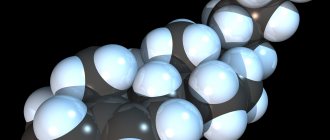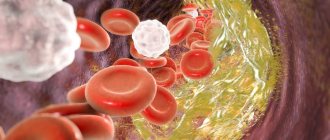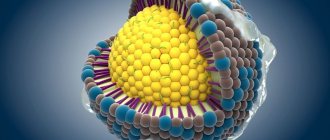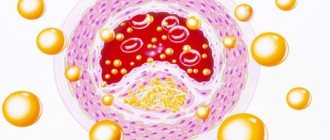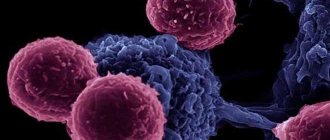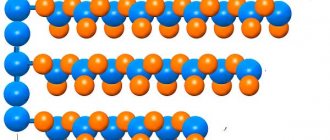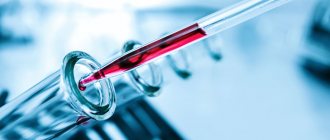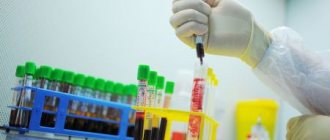Why is this dangerous?
Cholesterol is important for our body: being a component of the cell membrane, it is indispensable in the synthesis of hormones and the transport of other molecules.
But elevated levels of cholesterol and other fats provoke the development of atherosclerosis, in which plaques form from fats (lipids) circulating in the blood. Over time, there can be so many of them that the lumen of the vessel narrows completely, and life-threatening complications arise, including, for example, myocardial infarction.
Please note: you may not know that you have high cholesterol levels in your blood, since hyperlipidemia itself gives virtually no symptoms until it provokes other diseases, such as atherosclerosis. In other words, you can feel great while the pathological process progresses.
That's why it's important to check if your cholesterol and other fats are normal. Only a specialist can do this. Therefore, do not delay diagnosis if you want to prevent the development of dangerous diseases in time.
Make an appointment now.
Main characteristics
Obesity not only spoils a person’s appearance, but also causes diseases of internal organs.
- Hyperlipidemia is a group of disorders characterized by increased levels of blood cholesterol, especially its LDL fraction and/or triglycerides.
- Hypercholesterolemia usually does not cause any symptoms.
- Hypertriglyceridemia usually does not manifest itself in any way, but after triglyceride levels reach 1000 mg/dL, symptoms begin to appear: skin xanthomas and pancreatitis.
- Hyperlipidemia is believed to be inherited from parents, but its development is influenced by the following factors: certain diseases and medications, poor diet and alcohol.
- Medicines include: immunosuppressants, thiazide diuretics, progestins, retinoids, anabolic steroids, glucocorticoids, protease inhibitors, beta blockers.
- Diseases include: diabetes mellitus of both types, hyperthyroidism, Cushing's syndrome, chronic kidney disease, nephrotic syndrome, cholecystitis, cholelithiasis.
- Hyperlipidemia is a major and modifiable risk factor for cardiovascular disease.
- Therefore, the goal of treatment is determined by the level of cholesterol in the blood and the risk group in which the patient is located. Aggressive treatment aimed at achieving minimum cholesterol levels is prescribed to patients at high risk of heart attacks and strokes.
- Statistics show that effective therapy to reduce low-density lipoprotein levels leads to a sharp reduction in morbidity and mortality in both patients with existing coronary heart disease and in patients with initial manifestations of hypercholesterolemia.
Types of violations
There are several types of classifications of hyperlipidemia. The simplest one is by type of increasing the lipid fraction:
- hypercholesterolemia – increased total cholesterol;
- hypertriglyceridemia – increased concentration of triglycerides;
- hyperlipoproteinemia – abnormal levels of lipoproteins;
- hyperchylomicronemia – high chylomicrons.
However, in practice this approach is difficult to apply: most disorders occur with an increase in several types of fats. Therefore, more comprehensive typings have been developed.
According to the International Classification of Diseases, 10th revision (ICD-10), hyperlipidemia, along with other disorders of fat metabolism, is placed in a separate group - E78, consisting of several subgroups:
- E78.0 – pure hypercholesterolemia;
- E78.1 – pure hyperglyceridemia;
- E78.2 – mixed hyperlipidemia;
- E78.3 – other hyperlipidemias;
- 5. – hyperlipidemia, unspecified.
Types of hyperlipidemias
A lipidogram is a determination of a large number of indicators of various lipid fractions, and the classification of hyperlipidemia is based on the predominance of certain indicators. There is both an isolated increase in one of the fractions and an increase in all of a large number of indicators, as a result of which mixed hyperlipidemia is formed.
Primary, or hereditary hyperlipidemia, is divided according to the etiopathogenetic principles of its occurrence into five types:
— the first type of hyperlipidemia is currently a rare pathology, and the pathogenetic mechanism of its occurrence is based on a pronounced deficiency in the activity of lipase of the lipoprotein fraction, accompanied by an increased content of chylomicrons and triglycerides in plasma. This form of hyperlipidemia is not related to the development of atherosclerotic changes and is largely reflected in a decrease in pancreatic function. Correction of this hyperlipidemia involves sharply limiting fat intake;
- familial hyperlipidemia of the second type is caused by stimulation of the formation of beta-lipoproteins or their delayed destruction, as a result of which conditions are created for excessive accumulation of low-density lipoproteins. The debut of hyperlipidemic changes occurs in childhood, and in adolescence, most patients already have signs of the development of atherosclerotic heart disease. About 30% of cases of familial hyperlipidemia are accompanied by the development of signs of acute circulatory disorders in the system of coronary and cerebral large arterial vessels;
— the third type of hyperlipidemia is extremely rare and the appearance of its symptoms is due to the content of abnormal lipoprotein in the blood. The lipidogram of this category of patients undergoes significant changes with a predominance of very low density lipoproteins, which in the short term provoke the formation of atherosclerotic plaques;
— hyperlipidemia of the fourth type, which is based on an increased content of triglycerides in the blood plasma, is the most common form of lipid metabolism disorder. The risk group for this disease consists of middle-aged people suffering from pancreatic dysfunction and chronic changes in large vessels;
— pathogenetic mechanisms of the fifth type of hyperlipidemia are based on disruption of the processes of destruction and removal from the body of triglycerides supplied with food in excess quantities. The onset of the disease occurs in adolescence and manifests itself in pancreatic dysfunction with the subsequent development of symptoms.
Causes
Because LDL contains 65–75% of total plasma cholesterol, an increase in total cholesterol in the presence of normal triglyceride concentrations in fasting blood almost always reflects an increase in LDL cholesterol. Rarely, an increase in total cholesterol is caused by a significant increase in HDL cholesterol. The cause of primary hypercholesterolemia may be a mono- or polygenic disorder.
Familial hypercholesterolemia is a codominantly inherited disease caused by mutations in the LDL receptor gene. More than 200 such mutations are already known. The prevalence of the heterozygous form is 1:500. In familial hypercholesterolemia, both total and LDL cholesterol levels are elevated throughout life.
Due to the decrease in the number of LDL receptors, the removal of LDL apoprotein B is difficult. At the same time, the liver secretes more VLDL and LDLP, so more LDLP is converted into LDL instead of binding to liver receptors. In 75% of adults with familial hypercholesterolemia, intra- and extracellular cholesterol deposits manifest as tendon xanthomas, most often on the Achilles tendon and digital extensor tendons.
In the rare homozygous form of familial hypercholesterolemia (prevalence 1:1000,000), plasma cholesterol concentrations can exceed 13 mmol/l (500 mg%), which is accompanied by the appearance of large xanthelasmas, as well as tendon and flat xanthomas. Such patients often develop severe ischemic heart disease already in childhood.
This autosomal dominant disease is phenotypically similar to familial hypercholesterolemia and is caused by a substitution of the amino acid residue at position 3500 of apoprotein B100. As a result, the affinity of LDL for the LDL receptor is reduced and LDL catabolism is impaired. The prevalence and symptoms of the heterozygous and homozygous forms of this defect are similar to the congenital defect of the LDL receptor.
Typically, moderate hypercholesterolemia with a plasma cholesterol concentration of 6.5-9 mmol/l (240-350 mg%) is of polygenic origin. The pathogenesis of this hypercholesterolemia is believed to be due to excess production and delayed clearance of LDL as a result of a combination of multiple hereditary and environmental factors.
Genes that control the metabolism of cholesterol and bile acids play an important role. The severity of the disease depends on the amount of saturated fatty acids and cholesterol in food, age and physical activity. Triglyceride and HDL cholesterol levels are usually normal. There are no tendon xanthomas.
Hyperlipidemia
Elevated levels of lipids—triglyderides and cholesterol—in the blood are called hyperlipidemia. This condition is often caused by heredity.
There are five types of hereditary, or primary hyperlipidemia.
Type I hyperlipidemia is characterized by a high content of triglycerides in the blood, including chylomicrons. This can lead to the development of pancreatitis.
The diagnosis of “type II hyperlipidemia” is made in cases of high levels of low-density lipoproteins in the blood.
The level of triglycerides in the blood can be either normal (Pa type) or elevated (Pb type). Clinically, the disease manifests itself as atherosclerotic disorders, and sometimes coronary heart disease (CHD) develops. With this condition, heart attacks often occur in men over 40 years of age and women over 55 years of age.
Hyperlipidemia type III is an increased level of very low density lipoproteins and triglycerides in the blood. They accumulate in the blood due to a violation of the conversion of VLDL to LDL. This type of disease is often combined with various manifestations of atherosclerosis, including coronary artery disease and damage to the blood vessels of the legs. Such patients are prone to gout and diabetes.
Type IV hyperlipidemia - an excess of triglycerides in the blood with normal or slightly elevated cholesterol levels - is a risk factor for atherosclerosis, obesity and mild diabetes.
Type V hyperlipidemia - the body's inability to use and remove triglycerides from food - can be either hereditary or caused by an unhealthy lifestyle (alcohol abuse, poor diet, etc.). Coronary heart disease is not observed with this type of hyperliidemia.
However, this classification does not cover all possible deviations from the norm in the content of lipids and lipids in the blood plasma. In particular, it does not take into account changes in the concentration of HDL, a reduced content of which is an independent risk factor for the development of atherosclerosis and IVC, and an increased content, on the contrary, acts as a protective factor.
•too high calorie content or unbalanced diet;
•alcohol intoxication;
•diabetes;
•renal failure;
•taking certain medications (oral contraceptives, corticosteroids, etc.).
The causes of dyslipidemia can be congenital (single or multiple mutations that cause overproduction or defects in the release of triglycerides and low-density lipoproteins or hypoproduction or excessive excretion of high-density lipoproteins), or acquired. Most often, dyslipidemia is caused by a combination of several factors.
The main diseases that contribute to the development of this pathological process include diffuse liver diseases, chronic renal failure, and hypothyroidism. Dyslipidemia often occurs in patients with diabetes mellitus. The reason is the tendency of such patients to atherogenesis in combination with an increased concentration of triglycerides and low-density lipoproteins in the blood and a simultaneous decrease in the level of high-density lipoproteins. Patients with type 2 diabetes mellitus are at high risk of developing dyslipidemia, especially with a combination of low diabetes control and severe obesity.
Other risk factors include:
- the presence of dyslipidemia in a family history, i.e., hereditary predisposition;
- arterial hypertension;
- poor nutrition (especially overeating, excessive consumption of fatty foods);
- lack of physical activity;
- excess body weight (especially abdominal obesity);
- bad habits;
- psycho-emotional stress;
- taking certain medications (diuretics, immunosuppressants, etc.);
- age over 45 years.
Elevated blood cholesterol levels are usually the result of a complex of reasons, which usually include:
- Hereditary diseases
- Kidney disease, such as chronic renal failure
- Hypertension
- Diabetes
- Liver diseases, for example, acute and chronic hepatitis, cirrhosis of the liver
- Diseases of the pancreas, such as tumor, acute and chronic pancreatitis
- Diabetes
- Hypothyroidism
- Growth hormone deficiency
- Pregnancy – increases the amount of “bad” cholesterol and decreases the level of “good” cholesterol
- Alcohol abuse or overt alcoholism
- Smoking
- Metabolic disorders
- Obesity
- The use of certain medications, including oral contraceptives, steroid hormones, diuretics and a number of others
- Acquired chronic diseases in adulthood and old age
Gravity blood surgery is a new direction in medicine, which includes more than 30 high-tech methods, with the help of which pathological substances are removed from the body, the properties of blood cells and their number are changed, and medications are delivered directly to the site of the disease.
As a result of this blood purification, a clear effect of treating hyperlipidemia occurs even in cases where other methods do not help.
Proper nutrition and a healthy lifestyle are the main conditions for successful treatment and effective prevention of high cholesterol in particular and hyperlipidemia in general.
Lifestyle
- Strictly follow the diet prescribed by our specialists.
- Exercise, but avoid excessive exercise. Light fitness or swimming are ideal options.
- Never smoke or abuse alcohol again, and best of all, give up alcohol completely, including red wine.
- Sleep at least 8 hours a day.
- Make sure your blood pressure is normal.
- Don't be nervous about trifles, try to enjoy life.
- From time to time, cleanse your body of “bad” cholesterol using methods. gravity surgery.
Nutrition
Our specialists will select a diet individually, based on the level of fat in your body, as well as your taste preferences. Here we will give only general recommendations:
- Eliminate foods with saturated fats, trans fats and cholesterol from your diet
- Give up fast food forever
- Eat fruits and vegetables every day
- Eat more fish - sardines, salmon, mackerel and salmon. Fish is very healthy as it contains omega-3 fatty acids, which help reduce triglyceride levels
Please note: hyperlipidemia is a common pathology that is diagnosed in many people. If you feel well and do not complain about anything, this does not mean that the level of fat in your body is normal.
Therefore, do not hesitate to visit a doctor if you want to avoid serious complications.
Make a choice in favor of professional medicine!
KMN
KMN
KMN
DOCTORS
Classification
The classification of lipid disorders, based on changes in the profile of plasma lipoproteins during their electrophoretic separation or ultracentrifugation, was developed by Donald Fredrickson in 1965[1]. The Fredrickson classification has been adopted by the World Health Organization as the international standard nomenclature for hyperlipidemias.
A rare type of hyperlipidemia that develops due to LPL deficiency or a defect in the LPL activator protein, apoC2. Manifests itself in increased levels of chylomicrons, a class of lipoproteins that transport lipids from the intestines to the liver. The frequency of occurrence in the general population is 0.1%.
The most common hyperlipidemia. Characterized by an increase in LDL cholesterol. Divided into types IIa and IIb depending on the absence or presence of high triglycerides.
Classification of hyperlipidemia There are a number of reasons when a person may experience hyperlipidemia.
The fact is that heredity is the main cause of hyperlipidemia and also with it the disease can manifest itself at a young age.
Hyperlipidemia rarely occurs due to the fact that a person eats a lot of fat. With this image, a disease with high levels of fats in the blood appears extremely rarely, although this reason does exist.
Types of hyperlipidemia and the risk of developing atherosclerosis
- The first classification, or more precisely type hyperlipidemia (I), is extremely rare. But with this type, they are characterized by an increase in fat in the blood and also a significant decrease in the activator protein. Also, the indicators of all blood components may deviate from the norm.
- The second type of disease is hyperlipidemia (II), with this classification of the disease characterized by increased cholesterol. But it is worth considering that the second classification of this disease is divided into two subtypes, since with different subtypes of this disease it is very often possible to observe different indicators of components in the blood.
- (IIa) This type of disease most often occurs due to poor nutrition. This means that a person has an incorrect diet that is too high in fat. With this subtype of the disease, there is an increase in cholesterol and also various indicators of other components in the blood that are not normal. Also, this subtype can arise due to heredity. Under such circumstances, it is mainly the LDL receptor gene or apoB that mutates. In this situation, there is a possibility that both children and grandchildren will develop this disease.
- (IIb) the same type of hyperlipidemia is characterized by a high concentration of triglycerides. Also, this subtype can occur due to heredity and poor nutrition.
- The third type of disease (III) is characterized by the fact that in addition to the fact that blood counts are not normal, disturbances in the functioning of the body also occur. This is due to the fact that the disease begins to progress and thus the body itself begins to function incorrectly.
- The fourth type of disease (V) is very similar to the first type, as it has the same symptoms and characteristics. But the fact is that with this type, the indicators of all body functions only worsen, and also with this type, other diseases caused by hyperlipidemia can progress.
Special offers
Discount on installation of intragastric balloon – 15%
-15%
Participate
Free consultation with a doctor regarding the installation of an intragastric balloon
Participate
Free Bioimpedansometry during initial consultation on dietetics
Participate
Free initial consultation if an MRI scan is available to detect an intervertebral disc herniation
Participate
Free initial consultation if an MRI scan is available to detect an intervertebral disc herniation
Participate
Why does pathology develop?
All reasons that provoke an increase in fat concentration can be divided into 3 groups:
- primary (congenital) - various gene defects that are inherited;
- secondary (acquired) - diseases, lifestyle errors, medications that cause an increase in the concentration of one or more lipid groups;
- nutritional – associated with poor nutrition.
The main causes of various types of primary hyperlipidemia.
| View | Primary reasons | Secondary reasons |
| Hypercholesterolemia (type IIa) | Polygenic hypercholesterolemia |
|
| Familial hypercholesterolemia | ||
| Hypertriglyceridemia (type I or IV) | Familial hypertriglyceridemia |
|
| Combined hereditary hyperlipidemia | ||
| Hypercholesterolemia hypertriglyceridemia (IIb, III or V type) | Familial mixed hyperlipidemia |
|
| Familial dysbetalipoproteinemia | ||
| Severe hypertriglyceridemia in combination with moderate hypercholesterolemia (chylomicronemia) (type I or V) | Familial lipoprotein lipase deficiency |
|
| Familial apo-C-II deficiency |
Hyperlipidemia: symptoms
Most cases of hyperlipidemia, especially in the initial stages, are asymptomatic. This is explained by the peculiarities of the development of pathology. At first, the body is able to compensate for the increased fat content. Then comes the decompensation phase, when an imbalance of lipids provokes the onset of the development of systemic pathologies, which do not immediately manifest themselves clinically.
It can take years to go through all of these stages. Therefore, hyperlipidemia is often discovered accidentally during a routine examination or examination for another reason.
Signs of more severe disorders vary and depend on the nature of the disease. Hereditary forms can manifest themselves by the appearance of subcutaneous tumor-like formations (xanthoma) on various parts of the body, including the eyelids (xanthelasma), excess weight, and changes in the structure of the blood vessels of the eye. Symptoms of acquired hyperlipidemia are specific to each specific disease.
Let us note once again: the key danger of hyperlipidemia is that this pathological process itself practically does not manifest itself in any way.
If you like fatty and fried foods, do not disdain fast food, smoke, like to drink and do not really like sports, there is a high probability that you have high cholesterol levels in your blood.
Get checked to avoid life-threatening consequences. Make an appointment with our specialists right now.
WHAT IS HYPERLIPIDEMIA?
Hyperlipidemia
is a group of diseases that are characterized by abnormally high levels of fats in the blood. Although fats play a vital role in the body's metabolic processes, high blood fat levels increase the risk of coronary heart disease.
The two most common types of the disease are characterized by either high levels of cholesterol in the blood (hypercholesterolemia) or high levels of triglycerides (hypertriglyceridemia). Cholesterol is produced primarily in the liver and then distributed in the blood via low-density lipoproteins. (Because cholesterol and other fats do not dissolve in water, they cannot be carried by the blood themselves. Lipoprotein particles formed in the liver transport cholesterol and other fats through the blood.) Cholesterol is returned to the liver from the body's cells by another high-density lipoprotein. From there, cholesterol is secreted into bile either unchanged or after conversion to bile acids.
Cholesterol is important for the formation of cell membranes and the production of some hormones, but this does not require consuming dietary cholesterol since the liver produces all the cholesterol the body needs. If cholesterol levels in the blood are high, large amounts of so-called "bad cholesterol" can be deposited in the walls of the arteries. These deposits represent the first stage in a narrowing of the arteries called atherosclerosis. Since high blood cholesterol does not cause any symptoms, preventive measures and regular blood pressure measurements are necessary.
Diagnostics
A blood test called a lipid profile helps diagnose hyperlipidemia. Do not eat or drink anything for 9-12 hours before your blood draw.
The analysis will help assess the level of fats, identify or exclude changes in serum color characteristic of hyperlipidemia.
Important: in order to protect your health as much as possible, the lipid profile analysis must be repeated every 5 years.
If a blood test shows that you have high levels of cholesterol and other fats, your doctor may prescribe additional diagnostic tests that will help identify or rule out various associated pathological processes:
- Doppler ultrasound of blood vessels
- CT scan
- Angiography
- Additional laboratory tests
To diagnose hyperlipidemia and determine its type, a person only needs to take a specific blood test from a vein - a lipid profile. It allows you to evaluate the quantitative content of the main lipid fractions (total cholesterol, low, very low, high density lipoproteins, triglycerides), as well as their ratios.
The second stage of diagnosis is to determine the cause of the violation. This is a much more difficult task, because a wide variety of factors can provoke hyperlipidemia. Among all possible causes, the doctor selects those that are most likely given the existing clinical picture and medical history. The diagnosis is confirmed by instrumental methods. The patient's examination plan may include:
- general blood test, urine test;
- blood test for thyroid hormones;
- cardiogram;
- Ultrasound of the abdominal organs, heart, thyroid gland;
- Dopplerography;
- immunological testing;
- visual diagnostic methods (CT, MRI, X-ray).
After excluding all possible causes, a hereditary form of the pathology is suspected. The presence of some of its forms can be confirmed by genetic testing. If the diagnosis of hereditary hyperlipidemia is confirmed, the patient's siblings and parents are recommended to undergo similar testing.
The final stage of diagnosis is to assess the risk of the disorder for the person’s future life. One of the most common methods for calculating risk is the SCORE scale. This is a specific tool with which the doctor calculates the likelihood of death from cardiovascular diseases, taking into account the patient’s gender, age, systolic blood pressure, and total cholesterol concentration in the patient’s blood.
Dyslipidemia is essentially a laboratory indicator that can only be determined by the results of a biochemical blood test.
To determine the type of dyslipidemia, family history, objective examination and a number of additional studies are important.
A biochemical blood test allows you to determine the content of total cholesterol, low and high density lipoproteins, triglycerides, and the atherogenicity coefficient. To get a correct test result, blood must be taken in the morning on an empty stomach, and the day before you should refrain from excessive physical activity and eating fatty foods.
Additional laboratory tests: general blood and urine analysis, determination of homocysteine levels, blood glucose, creatinine, liver enzymes, thyroid-stimulating hormone, homocysteine, genetic testing.
Among instrumental diagnostic methods, ultrasound examination of blood vessels is used.
Diagnosis of hyperlipidemia
Since hyperlipidemia does not produce any symptoms for a long time, it is necessary to undergo regular blood tests. It is recommended to undergo such examination at least every 5 years after reaching the age of 20 years.
A blood test allows you to see the level of cholesterol and all its fractions. The attending physician will definitely compare the results obtained with the norm. Based on the results of the comparison, the doctor will decide what is necessary: prescription of medications, lifestyle changes, or a combination of these treatment methods. Also, using a special table, a therapist or cardiologist will determine the risk of developing a heart attack in the next 10 years.
A blood test shows levels of low-density lipoprotein (LDL, “bad cholesterol”), high-density lipoprotein (HDL, “good cholesterol”), total cholesterol and triglycerides. To reduce the risk of a heart attack, you should strive to:
- LDL less than 130 mg/dL
- HDL more than 40 mg/dl for men and more than 50 mg/dl for women
- Total cholesterol less than 200 mg/dl
- Triglycerides less than 200 mg/dL
It is believed that the lower the cholesterol and triglyceride levels, the better.
Features of treatment
If the risk of developing cardiovascular disease according to the SCORE scale is less than 5%, hyperlipidemia is treated without the use of drugs. Every 5 years, such patients undergo examinations with re-evaluation of their condition. If the risk remains low, the treatment regimen is not changed.
People who score 5% or more on the SCORE scale also undergo non-drug therapy. If within 3 months the total cholesterol level is normalized (below 5 mmol/l), treatment is continued without changes with the obligatory lipid profile 1 time/3 months. Patients whose total cholesterol concentration exceeds 5 mmol/l are prescribed lipid-lowering drugs.
It has been proven that hyperlipidemia in the initial stages can be easily removed without the use of drugs in many cases. Experts from the European Society of Cardiology and the European Society of Atherosclerosis recognized diet as the most effective way to reduce lipid levels. They managed to formulate 8 nutritional principles, the adherence to which perfectly lowers cholesterol, triglycerides, and LDL (3).
| Dietary principle | Implementation |
| Choosing foods low in saturated fat and cholesterol and replacing them with foods containing mono- and polyunsaturated fatty acids | It is necessary to eat less red meat, especially fatty varieties, lard, rendered animal fat, and dairy products with a high lipid content. From plant products - reduce the consumption of palm and coconut oils. Vegetable oils, seeds, flax seeds, chia, nuts, fatty fish, and avocados are rich in healthy, unsaturated fatty acids. |
| Limiting foods rich in simple sugars | In addition to the obvious sources of sugar (jam, sweets, sweet pastries, honey), there are hidden ones. Watch the amount of dried fruits you eat and fruit juices you drink. They contain huge amounts of sugar. |
| Avoiding trans fats | Trans fats are formed during the industrial processing of vegetable oils. At risk are margarine, as well as all products made with its addition. Information about the presence of trans fats must be printed on the packaging (nutrition section). |
| Increasing the amount of foods containing dietary fiber | Whole grain cereals, vegetables, herbs, fruits, legumes are a good source of fiber. You can also enrich your diet with dietary fiber through bran. |
| Limit alcohol consumption | Daily consumption of ethyl alcohol should not exceed 14 g for women, 28 g for men. |
| Enriching your diet with omega-3 fatty acids | Avocado, flax seeds, chia, walnuts and especially mackerel, salmon, herring, tuna, mackerel, anchovy should definitely be included in your diet. |
| Regular consumption of soy protein | Any soy products: tofu, vegetarian cutlets, goulash, soy milk, the beans themselves are good for lowering cholesterol |
| Taking dietary supplements containing phytosterols | Some plants contain phytosterols, substances that lower cholesterol. However, their content is not enough for a noticeable effect. Therefore, doctors recommend taking concentrated extracts of black cumin, sea buckthorn, and soybean to obtain maximum results. |
In addition to diet, fat content is normalized:
- reducing body weight to healthy levels (if it is excess);
- daily physical activity – at least 30 minutes/day;
- to give up smoking.
Medicines are prescribed to patients at risk of cardiovascular complications who are not helped by diet, exercise, smoking cessation, or weight loss. Reducing the concentration of all types of cholesterol and triglycerides is achieved by prescribing lipid-lowering drugs. These include:
- statins;
- fibrates;
- vitamin PP preparations (nicotinic acid);
- Omega-3 fatty acid preparations;
- cholesterol absorption inhibitors;
- fatty acid sequestrants.
The choice of drug depends on the type of fat metabolism disorder (table). Also, when prescribing treatment, the doctor takes into account the level of cholesterol, triglycerides, and the presence of concomitant diseases.
Tactics of drug treatment.
| Type of violation | Optimal drug |
| I | No drug treatment has been developed. Recommended diet |
| IIa | Statins, vitamin PP |
| IIb | Statins, vitamin PP, gemfibrozil |
| III | Mainly fibrates |
| IV | Mainly vitamin PP |
| V | Vitamin PP, gemfibrozil |
Treatment of secondary hyperlipidemia involves the prescription of medications that eliminate the cause of the disease, its symptoms, and prevent the development of complications.
Folk remedies
Hyperlipidemia, which does not require drug therapy, can be easily eliminated with “natural” medicines. Most of them are of plant origin, and the hypolipidemic effect is achieved by the biologically active substances included in their composition, which has been scientifically confirmed. The most powerful remedies include:
- Oat bran is a good source of soluble dietary fiber, which lowers bad cholesterol (LDL). They can be added to baked goods, soups, salads, and cereals. To achieve a therapeutic effect, you need to eat 5-10 g of bran daily.
- Ginger root is suitable for the treatment of hyperlipidemia and the prevention of atherosclerosis. According to the University of Maryland Medical Center, you should eat at least 4 grams of ginger every day. You can make drinks from the root of the plant, add it as a seasoning to sauces, vegetable dishes, soups, and baked goods.
- Garlic lowers triglycerides, LDL, and also prevents oxidation. It can be eaten raw, cooked, or taken as a tincture made from the spice. Peel and chop 250 g of garlic. Pour the resulting mass with 300 g of medical alcohol. Seal the container tightly and place in a dark place. After 3 days, carefully drain the top clear liquid and discard the remaining sediment. Take the tincture 10-15 drops 3 times a day. After 3 weeks, take a break.
- Fish oil is rich in omega-3 fatty acids, which effectively reduce triglyceride levels, less cholesterol, and vitamins A and E. Available in the form of capsules and liquids.
- Cilantro has an antioxidant effect, blocks the absorption of cholesterol from the intestines, and stimulates its use for the production of bile acids. Therefore, daily consumption of spices has a beneficial effect on blood lipid levels.
Causes of hyperlipidemia
The process of excessive accumulation of various lipid fractions in the human body, namely in the blood plasma, is influenced by a large number of etipathogenetic factors, some of which can be corrected by medicinal and non-medicinal methods, while others belong to the category of permanent risk factors.
Non-modifiable etiopathogenetic factors for the appearance of signs of hyperlipidemia are:
- gender (men are more predisposed to developing signs of one or another form of hyperlipidemia);
- elderly age of the patient;
- burdened heredity for a predisposition to the occurrence of diseases accompanied by hyperlipidemia.
The presence of one or a combination of these factors in a patient is the basis for the use of preventive measures to prevent complications that arise against the background of severe, prolonged hyperlipidemia.
Nevertheless, a large group of factors that provoke the development of hyperlipidemia are modifiable etiopathogenetic mechanisms, and in most cases, the elimination of these causes is accompanied by partial or complete elimination of signs of elevated lipid levels. This group of reasons consists of:
- long-term systematic consumption of foods rich in low-density lipoproteins and triglycerides;
- excess body weight due to massive development of adipose tissue;
- complete lack of physical activity;
- long-term systematic use of certain groups of medications (combined hormonal contraceptives, corticosteroids).
Consequences and complications
In the absence of treatment, against the background of dyslipidemia, vascular atherosclerosis develops, which results in: coronary heart disease, myocardial infarction, heart rhythm disturbances, heart failure, ischemic stroke, hypertension, intestinal infarction, intermittent claudication, trophic ulcers.
The main consequence of hyperlipidemia is atherosclerosis. This disease is accompanied by the formation of cholesterol plaques on the walls of blood vessels, impairing the patency of the arteries. Due to insufficient blood supply, the functioning of internal organs, especially the heart and brain, is disrupted. Further progression of atherosclerosis leads to myocardial infarction and stroke.
Dependence of atherogenicity on the type of hyperlipidemia.
| Phenotype | Atherogenicity |
| I | absent |
| IIa | high |
| IIb | high |
| III | high |
| IV | high or moderate |
| V | low |
The likelihood of the formation of cholesterol plaques with different types of lipid metabolism disorders is not the same. The most atherogenic hyperlipidemias are considered to be types IIa, IIb, and III. Type IV can also be highly atherogenic if the patient has low HDL levels and has carbohydrate metabolism disorders: elevated sugar levels, impaired glucose tolerance, insulin resistance (1).
Type V hyperlipidemia rarely leads to the development of atherosclerosis, and type I is not considered atherogenic at all.
Treatment and prevention of hyperlipidemia
How to treat hyperlipidemia? The algorithm for helping with the development of pathology depends on its type. In the early stages, it is often enough to adjust your diet and lifestyle; as the pathology progresses, medication therapy is necessary.
Therapy of initial degree of pathology
When preparing a diet, you need to pay attention to the following:
- reducing fat in the daily diet (the doctor selects the percentage of the daily value individually);
- increasing fiber intake;
- emphasis on healthy fats (nuts, seeds, vegetable oils, avocados, fish);
- if there are no contraindications, then soy products are included in the diet, which help reduce the level of LDL (low-density lipoprotein);
- legumes contain pectin, which helps remove cholesterol from the body;
- reduce coffee consumption;
- Red rice contains a natural statin – monacolin.
When adjusting your lifestyle, you should pay attention to the following points:
- Normalization of sleep patterns. Ideally, going to bed should be done before 23.00, the room should be well ventilated and darkened, since light interferes with the production of the hormone melatonin.
- Sports on a regular basis. It is better after consulting a doctor who will select the required minimum.
- Quitting active and passive smoking, which causes vasospasm and destroys its walls.
- Weight control. BMI is no more than 25, but sudden weight loss is undesirable, so consultation with specialists will not be superfluous.
- Blood pressure control.
- Quality rest and relaxation.
Hyperlipidemia quickly “responds” to changes in a person’s lifestyle. The best prevention of lipid metabolism disorders is sports, a balanced diet, annual monitoring of blood counts and adherence to sleep and wakefulness.
See also:
What is the normal blood cholesterol level in men?
Special offers
Discount on installation of intragastric balloon – 15%
-15%
Participate
Free consultation with a doctor regarding the installation of an intragastric balloon
Participate
Free Bioimpedansometry during initial consultation on dietetics
Participate
Free initial consultation if an MRI scan is available to detect an intervertebral disc herniation
Participate
Free initial consultation if an MRI scan is available to detect an intervertebral disc herniation
Participate
